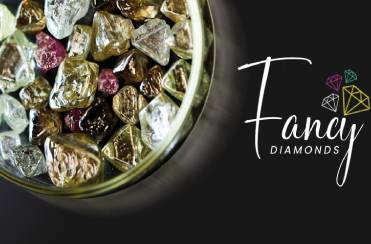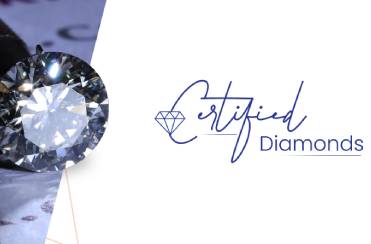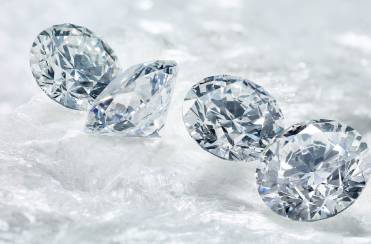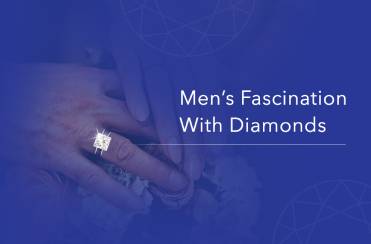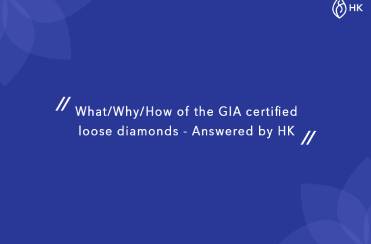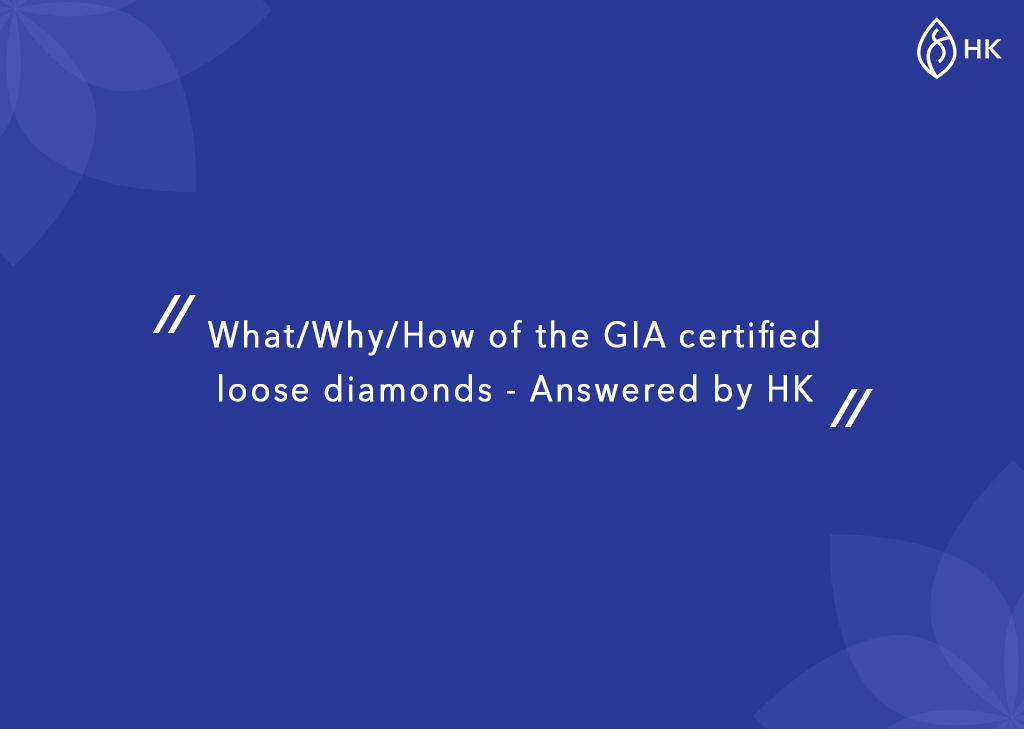
What/Why/How of the GIA certified loose diamonds - Answered by HK
When buying diamonds, we all prefer to buy certified diamonds from a reputable gemological laboratory, as it gives us proof of authenticity and peace of mind.
There are many reputable diamond grading laboratories in the world, such as the GIA, EGL, IGI, AGS, HRD, GSL, GSI, NGTC, etc.
Each of these labs has a distinct grading method and rating standards, as the diamond certification is subjective to labs.
These diamonds are graded on three different axes hue (the actual color - i.e., red, blue, green, or anything in between), tone (the relative lightness or darkness of the color), and saturation (how strong or weak the color is).
However, amongst all, the Gemological Institute of America (GIA) is considered the most trustworthy lab in terms of its grading standards in the diamond & jewellery industry.
Founded in 1931, GIA is an independent, nonprofit organisation that does R&D in the gem industry, defines and sets grading standards for diamond quality, and educates gem professionals.
GIA ensures that the diamond grading standards are fully objective; it keeps its all operations isolated from all the commercial trade, pricing, or valuation of diamonds.
In addition to that, GIA doesn't certify diamonds; it only grades them. Finding it hard to believe? It's true. Even GIA doesn't use the word certificate for the document it issues for the diamonds.
GIA just examines the diamond based on its properties and describes the results in the document it issues. GIA describes this document as a REPORT.
Although popularly referred to as the GIA certificate, this report comes in both paper and digital formats. Let's understand more about this report in detail:
What does GIA certified diamond mean?
As stated, the GIA diamond grading report gives the information about a diamond's 4Cs, its fluorescence, any treatments, etc., examined using the robust and latest technology to ensure the anonymity of the diamond and objectivity of its grading process.
GIA houses trained-eyed diamond grading professionals who meticulously examine the color, clarity, cut, carat weight, fluorescence, brilliance, the diamond's lustre, and improvements made to the diamond.
If we look into the grading procedures at GIA, the diamond is always placed in a transparent storage case after arrival at the lab.
Also, all the references to its owner are removed from the diamonds and assigned with a barcode label to track them throughout the process of grading.
If we consider the case of loose diamonds, they don't have very large ownership. Hence, GIA may employ more than one gemologist to grade and render their independent opinions on its quality.
It is to maintain accuracy and objectivity. Also, the grading report is not issued for the single loose diamond until sufficient consensus is reached.
All these steps ensure that the grading report objectively represents a diamond quality, which empowers buyers and sellers to compare the quality of loose diamonds more accurately.
Why buy GIA certified loose diamonds?
The benefits of buying GIA certified diamonds are extensive, but if we categorise them, they are as follows.
• The authenticity of diamond origin:
Though GIA has graded laboratory-grown diamonds since 2007, it clearly defines the origin of the diamond on its grading report.
The GIA provides the GIA Diamond Origin report and the diamond grading report, which gives customers the geographic origin of the diamond and heightened awareness of sustainability and ethically-sourced diamonds.
Analysed and developed using scientific methods, the GIA origin report also states the strong message of the good mined diamonds do for the country they come from in its report.
In the lab-grown diamond grading reports, GIA writes: 'This is a man-made diamond produced by CVD (Chemical Vapor Deposition)/HPHT (High-Pressure High Temperature) growth processes and may include post-growth treatments to change the color.'
This diamond origin service by GIA brings transparency to the diamond supply chain by connecting top diamond manufacturers, diamond miners, wholesalers, and retailers.
Hence, when buying GIA certified diamonds, you can be 100% sure that the diamond is natural or lab-grown, whose countries of origin have been scientifically confirmed by experts.
• Consistency of grading:
As stated, being a non-profit organisation, GIA maintains a standard of complete integrity and impartiality in all quality tests that yield specific results.
For example, GIA maintains the highest level of consistency in its grading results by grading diamonds in a consistent environment (same lighting, the same paint color on the walls) in all its laboratories.
It determines the carat weight of the diamond using a state-of-the-art electronic micro-balance scale and provides an exact measurement to five decimal places.
GIA determines diamond clarity under 10x magnification to isolate any imperfections within the diamond, even if they are not visible through naked eyes.
GIA clearly distinguishes flaws in the diamond, such as inclusions, clouding, pits, and poorly cut facets. It also mentions a pictorial illustration in a written report showing the location and severity of each flaw in the diamond.
Though being a tedious process, GIA examines the color, size, number, and location of the diamond inclusions, which helps determine the diamond's accurate clarity grade.
Such authenticated grading methods helps build a trustworthy customer experience, especially when you are one of the top Diamond companies.
• Transparency in the purchase:
GIA places security features within its grading report to prevent diamond certificate forgeries and alterations, including holograms, copy guards, and microprinting.
Additionally, GIA certified diamonds are laser inscribed with the unique report ID number, which is sometimes inscribed on the diamond's girdle that matches it with its corresponding quality report.
However, diamonds above 1 carat don't need such laser inscription since their inclusion pattern itself acts like a fingerprint to identify them.
If not satisfied, you can also double-check your grading report of your diamond on its online database as diamond eReports.
These are the features of GIA certified loose diamonds, which carries no additional risks when buying, even online.
After knowing what and why of the loose diamonds GIA certification, the important question - how to get the GIA certificate for your loose diamonds remained unsolved, so let's crack it.
Want to get your loose diamonds GIA certified? Here's how you get it done
You might be surprised to know that anyone can submit their diamond to GIA for grading. Yes, you can personally drop off or ship your diamond for GIA grading at any of its 9 labs around the world.
However, GIA only grades loose stones having a carat-weight of at least 0.15 Cents. Thus, if you want to GIA certify your loose diamonds that are set in a piece of jewellery, you first need to get them off the jewellery before sending it for grading.
Looking for GIA certified diamonds? Hari Krishna Exports is among the top 10 diamond companies of India and largest exporters of GIA certified loose diamonds , ranging from 0.18 cent to 50+ carats-sized diamonds in more than 9 shapes, including brilliant-round cut, FL to I3 clarity, and D to M Color across the 80+ countries of the world, including the USA, Hong Kong , China, Australia, Israel, the UK, Canada, etc.
